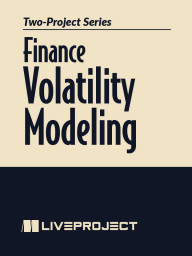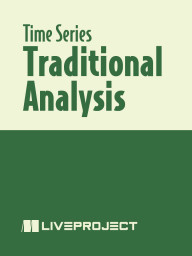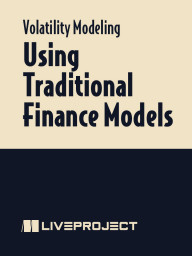projects by Abdullah Karasan
Finance Volatility Modeling
Are you ready to “explode” into the financial analysis-side of data science? Volatility is a factor in determining financial risk and it even makes appearances in option pricing formulas. In fact, volatility analysis is the backbone of finance modeling. In this liveProject series, you’ll learn to predict and model volatility, optimize model parameters, and choose the best financial model by analyzing and comparing prediction results. With the projects in this series, you’ll be managing financial risk like a pro with reliable and accurate volatility forecasts.
Time Series for Stock Price Prediction
In this liveProject series, you play the part of a consultant whose client list includes prestigious financial institutions. One of them has hired you to improve the accuracy of their model for stock price prediction. Since most financial data include a time dimension, time series analysis is a hot topic in finance—and an excellent application for this type of modeling. To help your client achieve their goal, you’ll perform the essential steps in time series modeling including data preparation as well as model performance analysis and comparison. First you’ll run classical moving average (simple MA and exponential MA), autoregressive (AR), and autoregressive integrated moving average (ARIMA) models. Then you’ll boost their performance by applying a hybrid approach that combines these models with deep learning models, leveraging the strengths of both. You’ll also learn to visualize results and evaluate performance.
Linear Regression for Asset Pricing
Linear regression is one of the most straightforward approaches to making price predictions and financial forecasts. In this series of liveProjects, you’ll step into the role of a machine learning engineer at InvRes Bank, a bank that offers financial consulting services to its customers. To better serve your clients, you'll develop regression-based Python machine learning models for financial modeling and asset pricing. You’ll update the classic financial algorithms Capital Asset Pricing Theorem (CAPM) and Arbitrage Pricing Theorem (APT) to new automatic machine learning models and improve your understanding of financial data science. These skills are in high demand for portfolio optimization and financial services.
Hybrid Model
Now that you’ve prepared the data for the deep learning models, you’re ready to apply the hybrid model, which leverages the strengths of both the classical and deep learning models. In this liveProject, you’ll focus on the essential steps for running a time series analysis. You’ll start with ensuring the data you prepared is ready for processing with the deep learning models. Next, you’ll run the RNN and LSTM for the separate datasets. Finally, you’ll evaluate the performance of your models.
Deep Learning
You’ve shown your expertise in successfully modeling a time series using classical models: moving average (simple MA and exponential MA), autoregressive (AR), and autoregressive integrated moving average (ARIMA). Your next step is to determine if there’s a way to boost the performance of the time series analysis. You decide you’ll apply an unconventional approach that’s increasingly popular in finance circles: a hybrid model that combines deep learning and classical approaches. For the deep learning models, you choose recurrent neural network (RNN) and long short-term memory (LSTM). In this liveProject, you’ll focus on preparing the data for the deep learning models. The good news is that in deep learning models, you avoid a long and cumbersome preprocessing stage since, unlike in many classical approaches, they are able to detect patterns almost automatically.
Traditional Analysis
Now that you’ve detected the time series components and obtained the stationary data, you’re ready to move on to time series modeling. In this liveProject, your challenge is to determine which model will perform best for your client’s data. To do this, you’ll apply the classical moving average (simple MA and exponential MA), autoregressive (AR), and autoregressive integrated moving average (ARIMA) models. Then you’ll compare their performance using a visualization and performance metric, root mean square error (RMSE).
Time Series Components
Imagine you’re a consultant with a number of prestigious financial institutions on your client list. One of them has hired you to increase the accuracy of their model for predicting stock prices. You rise to the challenge, deciding on some classical time series models. But before you can propose a reliable model, you must decompose and examine the time series data in order to understand its pattern. Once you have a firm grasp on the data’s peculiarities, you’ll be ready to run the time series modeling.
Arbitrage Pricing Model
In this liveProject, you’ll build a machine learning system based on the Arbitrage Pricing Theorem (APT) that can create a diversified investment portfolio designed to avoid risks. APT allows you to model the effects of different scenarios on an investment portfolio, and you’ll test this theorem on a portfolio of social media companies. You’ll run analysis to estimate coefficients, and conduct sensitivity analysis to determine important macroeconomic factors. Finally, you’ll interpret your results to find out what issues your portfolio is the most sensitive to.
Using Machine Learning
Now that you’ve tackled volatility modeling in a traditional way, in this liveProject, your employer has challenged you to uplevel your volatility modeling by taking a more dynamic, data-dependent approach. By the end of this project, you’ll have firsthand experience modeling volatility using support vector machines with different kernels, neural networks, and deep learning models. What’s more, you’ll have the skills to determine if the machine learning-based models outperform the traditional parametric models.
Using Traditional Finance Models
In this liveProject, you’ll play the part of a freelance consultant who’s been hired to assess a company’s financial risk. Using the traditional volatility modeling packages ARCH and GARCH, you’ll model the volatility of S&P-500 stock prices—a good proxy for the entire financial market—and measure model performance. Then, you’ll optimize the model parameters using information criteria such as Bayesian Information Criteria (BIC). When you’ve completed the project, you’ll have a solid understanding of the logic of these traditional models and be ready to apply it to other models.
Capital Asset Pricing Model
In this liveProject, you’ll build a machine learning system based on the Capital Asset Pricing Model (CAPM) that can determine if certain stocks are over or undervalued, and the risk level of these stocks relative to the market index. CAPM is a powerful tool in finance due to its intuitive and easy-to-apply nature, and in this project you’ll use it to estimate coefficients, determine valuation accuracy, and finally find which stock promises the best risk-return relationship.










